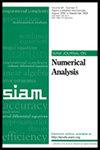基于群的梯度下降与模拟退火
IF 2.9
2区 数学
Q1 MATHEMATICS, APPLIED
引用次数: 0
摘要
SIAM 数值分析期刊》,第 62 卷,第 6 期,第 2745-2781 页,2024 年 12 月。 摘要我们介绍了一种用于非凸优化的新方法,称为基于蜂群的模拟退火(SSA),它处于基于蜂群的梯度下降(SBGD)[J. Lu et al.Lu et al., arXiv:2211.17157; E. Tadmor and A. Zenginoglu, Acta Appl.Cerny, J. Optim.Theory Appl., 45 (1985), pp.控制优化》,24 (1986),第 1031-1043 页]。与 SBGD 类似,我们引入了一个代理群,每个代理都有一个位置[math]和质量[math],以探索环境空间。与 SA 类似,代理群沿着梯度下降方向前进,并受布朗运动的影响。不过,退火率是由质量的递减函数决定的。因此,与 SA 的温度随时间递减的协议不同,在这里,虫群根据其自身累积的质量来决定如何 "冷却 "虫体。质量的动态与位置的动态相耦合:处于较高位置的虫群会将(部分)质量转移给处于较低位置的虫群。因此,由此产生的 SSA 优化器被动态地划分为:较重、较冷的代理被视为 "领导者",较轻、较热的代理被视为 "探索者"。平均场收敛分析和基准优化证明了 SSA 方法作为多维全局优化器的有效性。本文章由计算机程序翻译,如有差异,请以英文原文为准。
Swarm-Based Gradient Descent Meets Simulated Annealing
SIAM Journal on Numerical Analysis, Volume 62, Issue 6, Page 2745-2781, December 2024.
Abstract. We introduce a novel method, called swarm-based simulated annealing (SSA), for nonconvex optimization which is at the interface between the swarm-based gradient-descent (SBGD) [J. Lu et al., arXiv:2211.17157; E. Tadmor and A. Zenginoglu, Acta Appl. Math., 190 (2024)] and simulated annealing (SA) [V. Cerny, J. Optim. Theory Appl., 45 (1985), pp. 41–51; S. Kirkpatrick et al., Science, 220 (1983), pp. 671–680; S. Geman and C.-R. Hwang, SIAM J. Control Optim., 24 (1986), pp. 1031–1043]. Similarly to SBGD, we introduce a swarm of agents, each identified with a position, [math] and mass [math], to explore the ambient space. Similarly to SA, the agents proceed in the gradient descent direction, and are subject to Brownian motion. The annealing rate, however, is dictated by a decreasing function of their mass. As a consequence, instead of the SA protocol for time-decreasing temperature, here the swarm decides how to “cool down” agents, depending on their own accumulated mass. The dynamics of masses is coupled with the dynamics of positions: agents at higher ground transfer (part of) their mass to those at lower ground. Consequently, the resulting SSA optimizer is dynamically divided between heavier, cooler agents viewed as “leaders” and lighter, warmer agents viewed as “explorers.” Mean-field convergence analysis and benchmark optimizations demonstrate the effectiveness of the SSA method as a multidimensional global optimizer.
Abstract. We introduce a novel method, called swarm-based simulated annealing (SSA), for nonconvex optimization which is at the interface between the swarm-based gradient-descent (SBGD) [J. Lu et al., arXiv:2211.17157; E. Tadmor and A. Zenginoglu, Acta Appl. Math., 190 (2024)] and simulated annealing (SA) [V. Cerny, J. Optim. Theory Appl., 45 (1985), pp. 41–51; S. Kirkpatrick et al., Science, 220 (1983), pp. 671–680; S. Geman and C.-R. Hwang, SIAM J. Control Optim., 24 (1986), pp. 1031–1043]. Similarly to SBGD, we introduce a swarm of agents, each identified with a position, [math] and mass [math], to explore the ambient space. Similarly to SA, the agents proceed in the gradient descent direction, and are subject to Brownian motion. The annealing rate, however, is dictated by a decreasing function of their mass. As a consequence, instead of the SA protocol for time-decreasing temperature, here the swarm decides how to “cool down” agents, depending on their own accumulated mass. The dynamics of masses is coupled with the dynamics of positions: agents at higher ground transfer (part of) their mass to those at lower ground. Consequently, the resulting SSA optimizer is dynamically divided between heavier, cooler agents viewed as “leaders” and lighter, warmer agents viewed as “explorers.” Mean-field convergence analysis and benchmark optimizations demonstrate the effectiveness of the SSA method as a multidimensional global optimizer.
求助全文
通过发布文献求助,成功后即可免费获取论文全文。
去求助
来源期刊
CiteScore
4.80
自引率
6.90%
发文量
110
审稿时长
4-8 weeks
期刊介绍:
SIAM Journal on Numerical Analysis (SINUM) contains research articles on the development and analysis of numerical methods. Topics include the rigorous study of convergence of algorithms, their accuracy, their stability, and their computational complexity. Also included are results in mathematical analysis that contribute to algorithm analysis, and computational results that demonstrate algorithm behavior and applicability.

 求助内容:
求助内容: 应助结果提醒方式:
应助结果提醒方式:


